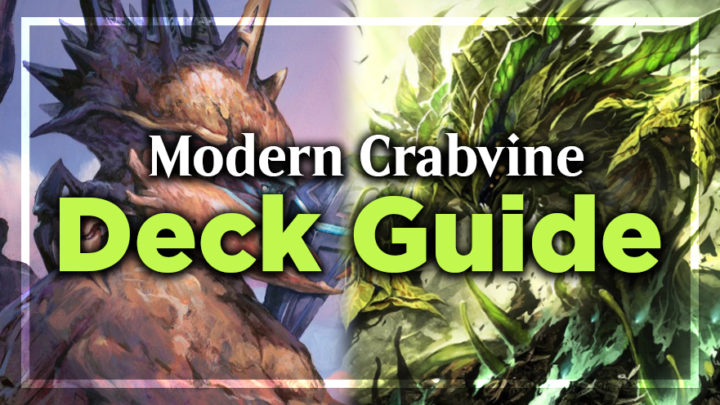It’s about time that graveyard decks popped back up in Modern. Traditionally, whenever Modern becomes centered around interaction, decks like Dredge creep back into the metagame to exploit the midrange decks. Without Faithless Looting, Dredge is only at a fraction of its former power level, which allows other decks to challenge it for the title of Best Graveyard Deck. Last weekend, Erik157751 nearly won the Modern Challenge on MTGO with Crabvine, and now seems like a perfect time to pick up Vengevine and friends. Let’s break this deck down!
The Deck

View decklist
Buy this deck from Card Kingdom
At its base level, Crabvine is a graveyard-fueled aggro deck. The term “graveyard aggro” may sound weird, but I believe that’s the best way to describe it.
First and foremost, this deck is looking to “combo.” The strength of Crabvine is that it can create a dominant board presence early enough that many decks will simply be unable to get a foothold. In the early turns, you’ll want to get as much of our cards into the graveyard as possible; it’s fairly common to see anywhere between four and seven power on the board as early as turn two.
Just as you would while playing Dredge, you do need to flip the right combination of cards to really explode off the starting line. What happens if you don’t hit the right mix of cards? Well, unlike Dredge, Crabvine still can play a reasonable aggro game. Instead of Stinkweed Imps and Golgari Thugs, you get to play Gravecrawler, Vengevine, and Gurmag Angler to try and close out the game.

Most Crabvine cards fall into two categories: enablers and payoffs. The correct mix is key to ensure that the deck functions. Too many of either and suddenly you’re either spinning your wheels or stuck with a hand full of cards that don’t do much.
Merfolk Secretkeeper, Hedron Crab, Glimpse the Unthinkable, and Stitcher’s Supplier are the enablers. With the exception of Glimpse the Unthinkable, all these enablers cost one mana, which is crucial to getting the ball rolling as early as possible.
Okay, so we know what our enablers are, but what are they enabling? A full suite of recursive graveyard-based threats provide both speed and resilience to removal spells. Gravecrawler, Gurmag Angler, Narcomoeba, Prized Amalgam, Silversmote Ghoul, Uro, Titan of Nature’s Wrath, Creeping Chill, and Vengevine are all significantly better when you have a stocked graveyard. Narcomoeba, Uro, Silversmote Ghoul, Gravecrawler and Creeping Chill all pull double duty as enablers and payoffs — they give you something on their own, but also make it possible to put Prized Amalgam, Vengevine and Silversmote Ghoul into play early to turn up the heat.
Back from the Dead
Let’s take a moment to look at just how each of the graveyard threats makes its way from the dumpster to the battlefield:

Prized Amalgam: When a creature enters play from the graveyard. The easiest way to trigger Prized Amalgam is by milling Narcomoeba while Amalgam is in the graveyard. However, there are plenty of other ways to bring back our favorite Trained Armodon: cast Gravecrawler from the graveyard, escape Uro, cast two creatures in the same turn with a Vengevine in the graveyard, or gain three life with Silversmote Ghoul in the graveyard.

Gravecrawler: Simply have a zombie in play, and there are plenty in the deck: Stitcher’s Supplier, Gravecrawler, Gurmag Angler, Prized Amalgam, Silversmote Ghoul. Chances are, if you have a creature on the battlefield, you’ll probably be able to cast Gravecrawler from the graveyard.

Silversmote Ghoul: Gain three life a turn. The nice part is, this is an end step trigger; you don’t need Ghoul in the graveyard when you gain life, as long as it ends up there by the beginning of the end step. Creeping Chill and Uro provide Crabvine with the needed outlets to gain enough life to trigger Silversmote Ghoul. Remember, if you have both a Silversmote Ghoul and a Prized Amalgam, the Ghoul will trigger and create a delayed trigger to return Amalgam on the next end step.

Vengevine: The important thing to remember about Vengevine is that it can only enter the battlefield if it was in the graveyard when you cast your second creature spell for the turn. For example, if you were to cast Uro and draw a Stitcher’s Supplier, cast Supplier, flip over Vengevine and then cast a Gravecrawler from the graveyard, the Vengevine won’t come back.

Gurmag Angler and Uro, Titan of Nature’s Wrath: I’ve lumped these together because they’re both enabled by the leftovers in the graveyard. It may seem counterproductive to play creatures that eat cards from your graveyard in your graveyard deck, but they actually work well. When you’re milling yourself for value, you’ll naturally flip over lands and enablers that don’t provide any value in the graveyard; these are the perfect cards to fuel Gurmag Angler and Uro.
The Sideboard

Crabvine’s sideboard is exactly what I’d expect to see: twelve cards that beat hate cards and three copies of Leyline of the Void for other graveyard decks. Due to the recursiveness of the creatures in Crabvine — along with the speed that early Vengevines and Creeping Chills can apply — your opponents’ removal spells often won’t mean much. This means that opponents will often need to turn to cards that specifically interact with the graveyard, with Leyline of the Void and Rest in Peace being common options.
It makes sense to load up on answers to Leyline of the Void, as it’s the only card fast enough to significantly disrupt Crabvine. Rest in Peace is often beatable with a good start, especially if you’re on the play. Fatal Push also makes an appearance in this sideboard to deal with the likes of Containment Priest, Scavenging Ooze, and Yixlid Jailer.
Sequencing

Sequencing matters in Magic across the board, but Crabvine is one of the more challenging decks to sequence. Vengevine is the root of most sequencing obstacles because of its time-sensitive trigger. The general rule of thumb is to lead with non-creature spells to mill yourself and give yourself the most flexibility as you progress through the turn.
The main exception to this is on turn one, when you want to put as many cards in your graveyard as possible. For example, if your opening hand has a Merfolk Secretkeeper and a Stitcher’s Supplier, you’ll want to lead with Venture Deeper. That way, if you flip a Vengevine with Venture Deeper or with the Stitcher’s Supplier on turn two, Supplier and Secretkeeper will give you a turn two Vengevine.
Another general rule is to get Hedron Crab into play as soon as possible. Maximizing the number of cards you can put in your graveyard before you play your second creature in a turn is going to net you some free Vengevine equity. If you have Hedron Crab in play, you’ll want to play as many lands as possible before you start casting creatures. Uro interacts nicely here, as it can let you mill up to twelve cards in a single turn if you start with a Hedron Crab, and it leaves room to cast a second creature.
Why is Crabvine Good?

Crabvine is good for a few reasons, but they all boil down to people sleeping on graveyard hate. Modern is full of high-curve midrange decks right now, which is the natural playground for Crabvine.
When these midrange decks are popular, a couple things tend to happen. First, other, slightly larger midrange decks show up to beat those midrange decks. Then control decks try to beat the bigger midrange decks. But once the metagame reaches that upper limit, it becomes better to be two steps smaller instead of another one step bigger.
Second, in a midrange arms race, graveyard hate starts to become scarce as players load their sideboards with mirror tech. Once graveyard hate drops below a certain threshold and the midrange decks start to cannibalize themselves, the graveyard becomes your most powerful resource.
In this scenario, you simply get to play a different game than your opponent. They showed up prepared to kill some creatures, counter some spells, and snowball value into a longer game; you don’t care if they kill your creatures, because they’ll just come back. Making your opponents’ interaction ineffective is fairly close to card advantage, and you already leverage a mana advantage, as your creatures didn’t cost you much.
What Beats Crabvine?

We know that Crabvine beats up the midrange decks, but what beats up on Crabvine? Honestly, not a ton! Crabvine tends to lose to specific cards instead of decks, as you can tell from Erik157751’s sideboard. Decks that have available sideboard space for hard graveyard hate will at least have a fighting chance in the sideboard games.
There is one weakness that graveyard decks across Modern share: combo decks. Part of the reason that Crabvine is a good choice at the moment is because combo is low on representation. This is partially because some key combo cards are banned, and partially because Force of Negation is popular.
Oops All Spells and Selesnya combo decks (Heliod/Devoted Druid) would be my picks as the worst match-ups for Crabvine currently. In order to beat these decks, you need to pressure their resources and their life total. Crabvine simply can’t do a good job at straining the resources of combo decks, which means that all you can really do is try to be faster. The sideboard provides small amounts of interaction for creatures in the form of Abrupt Decay, Fatal Push, and Assassin’s Trophy, but casting those cards often takes a good bit of the wind out of your sails in the early turns.
Conclusion
Graveyard decks in Modern are only powerful as long as most players aren’t stopping you. Right now is a great time to exploit that weakness, as no one seems dedicated to beating Crabvine for the time being. Is Crabvine a deck that interests you enough to pick it up for your next event? Do you have some sweet tech to improve the deck? Be sure to let me know on Twitter at @RappaciousOne! Until next week, stay safe.

Michael Rapp is a Modern specialist who favors Thoughtseize decks. Magic sates his desire for competition and constant improvement.

